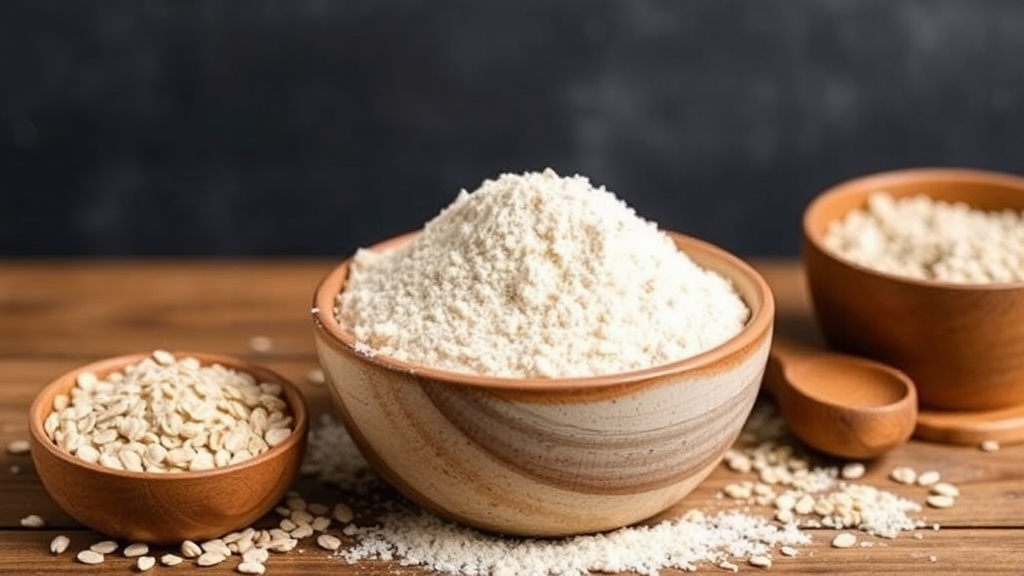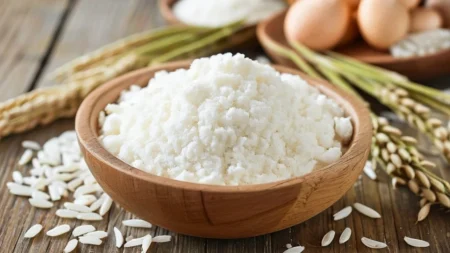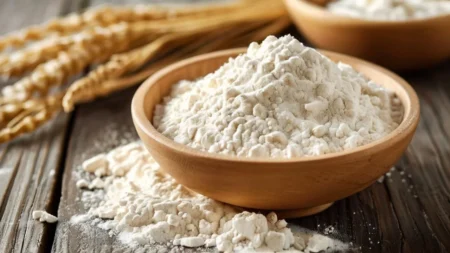Oat Flour: A Gluten-Free Alternative with Impressive Health Benefits
Key Takeaways:
- Oat flour is a nutritious, gluten-free flour alternative made from ground oats.
- It offers health benefits such as supporting heart health, improving digestion, and regulating blood sugar.
- Oat flour can be used in baking, cooking, and as a thickening agent in both sweet and savory dishes.

Nutritional Profile of Oat Flour
Oat flour is packed with nutrients that make it a wholesome choice for a wide range of diets. Here is the nutritional breakdown for one cup (120 grams) of oat flour:
| Nutrient | Amount |
|---|---|
| Calories | 455 kcal |
| Carbohydrates | 68 grams |
| Protein | 15 grams |
| Dietary Fiber | 8 grams |
| Fat | 9 grams |
| Iron | 4.3 mg (24% DV) |
| Magnesium | 276 mg (69% DV) |
| Phosphorus | 816 mg (117% DV) |
Rich in Fiber and Protein
Oat flour is notably high in dietary fiber, particularly beta-glucan, which is beneficial for heart health. It also contains a significant amount of protein compared to other gluten-free flours.
Health Benefits of Oat Flour
1. Supports Heart Health
Oat flour contains beta-glucan, a type of soluble fiber known for its ability to lower LDL (“bad”) cholesterol levels. This helps reduce the risk of heart disease and supports overall cardiovascular health.
2. Aids in Digestion
The high fiber content in oat flour promotes healthy digestion by supporting bowel regularity and preventing constipation. Fiber also feeds the good bacteria in the gut, contributing to a balanced microbiome.
3. Regulates Blood Sugar Levels
The soluble fiber in oat flour helps slow the absorption of sugar into the bloodstream, which prevents spikes in blood sugar. This makes it a great choice for individuals managing diabetes or prediabetes.
Oat Flour vs. Other Gluten-Free Flours
When compared to other gluten-free flour options, oat flour stands out for its nutritional profile and health benefits:
| Nutrient (Per 100g) | Oat Flour | Almond Flour | Coconut Flour |
|---|---|---|---|
| Calories | 380 kcal | 571 kcal | 400 kcal |
| Carbohydrates | 67 grams | 22 grams | 60 grams |
| Protein | 14 grams | 21 grams | 18 grams |
| Dietary Fiber | 10 grams | 12 grams | 36 grams |
| Fat | 7 grams | 50 grams | 12 grams |
Oat flour is higher in carbohydrates and fiber compared to almond and coconut flours, making it a versatile and nutritious option.
How to Use Oat Flour
Oat flour can be used in various recipes, from baked goods to savory dishes. Here are a few ways to incorporate it into your cooking:
1. Baking with Oat Flour
Oat flour works well in baked goods like muffins, pancakes, and cookies. It provides a slightly nutty flavor and a soft, tender crumb. You can substitute oat flour for all-purpose flour in many recipes, but it is best to mix it with other flours for better structure in breads and cakes.
2. Thickening Agent
Oat flour can be used as a natural thickening agent in soups, sauces, and gravies. Its high fiber content allows it to absorb liquid and create a smooth texture.
Oat Flour in Gluten-Free Diets
For individuals following a gluten-free diet, oat flour is a valuable option. However, it is important to use certified gluten-free oat flour, as oats are often processed in facilities that handle gluten-containing grains.
1. Gluten-Free Baking
Oat flour can be used as part of a gluten-free flour blend in cakes, cookies, and breads. It provides a mild flavor and helps retain moisture in baked goods, making them less crumbly.
2. Nutrient Boost in Smoothies
Adding a tablespoon of oat flour to smoothies increases their fiber content and creates a thicker, more satisfying drink.
Oat Flour vs. Whole Oats
While both oat flour and whole oats come from the same source, they have different textures and uses. Here’s a comparison of their nutritional profiles:
| Nutrient (Per 100g) | Oat Flour | Whole Oats |
|---|---|---|
| Calories | 380 kcal | 389 kcal |
| Protein | 14 grams | 17 grams |
| Dietary Fiber | 10 grams | 11 grams |
| Carbohydrates | 67 grams | 66 grams |
Oat flour is simply whole oats that have been ground into a fine powder. While their nutritional content is very similar, oat flour is more versatile in cooking and baking due to its fine texture.
Conclusion
Oat flour is a highly nutritious and versatile ingredient that can enhance the healthiness of both sweet and savory dishes. Its rich content of fiber, protein, and essential vitamins and minerals makes it an excellent choice for heart health, digestion, and blood sugar regulation. Whether you’re baking muffins, thickening sauces, or boosting your fiber intake, oat flour is a wholesome and gluten-free option to keep in your pantry.
FAQ
Q: Can I make my own oat flour at home?
A: Yes! Simply blend whole oats in a food processor or blender until they reach a fine, flour-like consistency.
Q: Is oat flour gluten-free?
A: Oats are naturally gluten-free, but cross-contamination can occur during processing. Look for certified gluten-free oat flour if you have celiac disease or gluten sensitivity.
Q: Can I use oat flour as a 1:1 substitute for all-purpose flour?
A: Oat flour is lighter than all-purpose flour, so it is not always a perfect 1:1 substitute. It works best in combination with other flours or when used in recipes designed specifically for oat flour.










